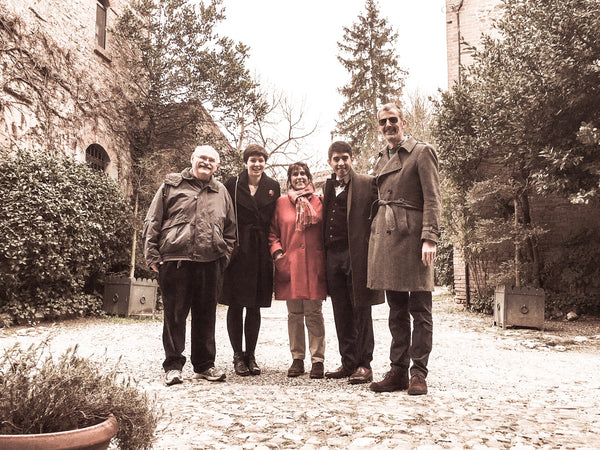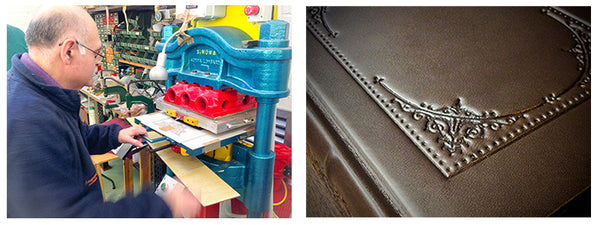The Scriptum Blog / Made in Italy
The making of an Italian leather bound journal
In a quest for some exciting new lines for this spring, we decided it was time to pay a visit to one of our suppliers to see exactly how their leather bound journals are made. We like to know precisely where our stock comes from, as we want to be able to talk with confidence about every detail of a product’s journey: its materials, its history, its creation. Provenance is important; before becoming part of your story, a journal has a tale of its own.

Amarcord is an Italian bindery based in Piacenza, a beautiful cobbled and campanile-dotted town halfway between Milan and Bologna. The company’s name is a local dialect word for “I remember” in a rather nostalgic sense - very fitting for a maker of journals, the repositories of memories and dreams. We have been working with Amarcord for a number of years, and as well as many of our best-selling journals, they also supply some of our music manuscript journals, wine records and restaurant books, so we were rather excited to meet the craftsmen who make them.
Amarcord is run by third generation leathersmith Sergio, whose grandfather set up the company, originally to make leather luggage and belts, shortly after returning from the second world war. Sergio's father eventually took over the business, and then Sergio in his turn, building on the years of family experience in leatherwork to specialise in journals and binding. He works closely with his colleague Daniela, who is Piacenza born and bred, and passionate about not only Amarcord journals but all the produce and history of their region. When not hard at work in the workshop itself, Sergio and Daniela sit in their office at patchwork leather desks (made in-house, naturally) drinking fragrant espresso and arranging the distribution of their journals all around the world.

The workshop is a light, airy building a few miles from the city centre, filled with the heavy scent of leather, paper, and glue, and the clatter and whir of machines ticking over, waiting to be used by the small team of leatherworkers. With this artisan style of production, each journal comes under Sergio's watchful eye and allows him to ensure the quality of every piece is up to his standards.

The journal-making process begins with the leather. The leather for our Verona journals comes from the Veneto, where the cow hides are tanned, dyed, and greased to give their distinctive soft suede-like texture. The leather for our Trieste journals and Embossed Window journals with a smoother, shinier finish, comes from nearby Tuscany. Amarcord have dozens of other styles and colours of hides stacked in rolls along one wall of the workshop - it’s difficult to pass by without stroking each one to feel the grain and finish, and nigh on impossible for us to decide which we want to use for our order. After poking, prodding and a good deal of sniffing, we finally pick out our favourites to make up the journals which will arrive in Oxford in the spring.


Once we have selected the type of leather, it is taken it to the cutting press. Sergio chooses a sharp-edged press, exactly like an industrial-strength cookie-cutter, for whichever shape of cover he needs, and positions it carefully on top of the hide. The heavy stamp is brought down hydraulically, pushing the sharp edge of the press cleanly through the tough leather to leave the basic shape of the journal, and sometimes a double hole for a tie-closure. 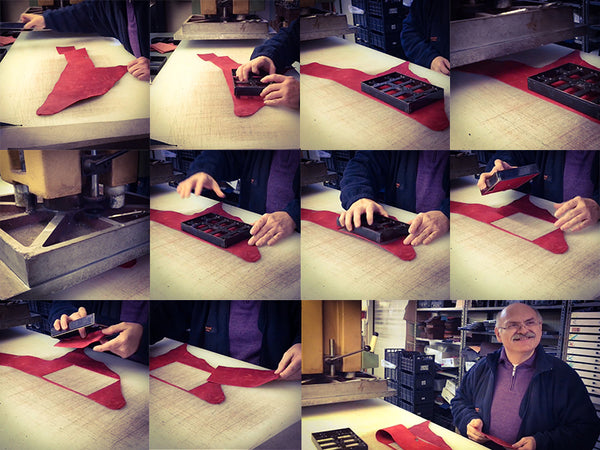
If it is a hardback, the leather now needs to be attached to a thick layer of mount board to give it stiffness and shape. For spines with the traditional ridges, a piece of ridged board is also added to give the leather its characteristic shape after a short stint in a curved spine press. Now comes the embossing. Metal blocking dies with a bewildering array of patterns are neatly filed in drawers, ready to stamp their pattern onto the leather. To do this, the die is positioned in a stamping machine which heats the metal to 125°C before bringing it down on the leather. The heat and the pressure stamp the pattern indelibly onto the leather’s surface. 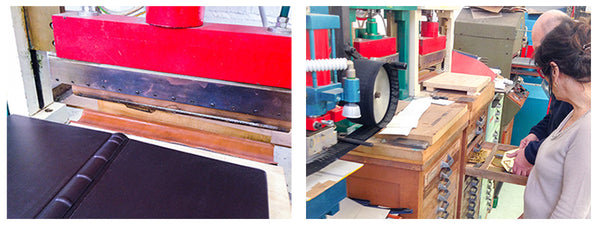
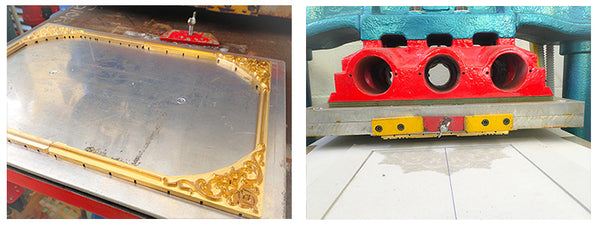
The next step is the block; a bound collection of pages to put inside the journal. Amarcord use Italian-made book blocks with 85gsm acid-free paper as standard (120gsm for sketch books). The leaves within the block are stitched together as well as glued at the spine, leaving the pages firmly and tightly bound even if the journal is opened completely flat or folded back on itself. Laura Berretti, an expert in traditional Italian marbling techniques, also sends Amarcord blocks with hand-marbled edges from her atelier in Florence. These are the blocks used in our Trieste journals. For books with handmade paper, luxurious deckle-edged Amatruda Amalfi paper is stitched together by hand in the workshop to create the block from scratch. 

If the block needs to be resized, or mount board cut, there are a pair of guillotines for the job. One is a modern machine, which you have to press two buttons about a metre apart to operate - the idea is that as you need two hands to bring the guillotine down, you can't accidentally chop off your own fingers by mistake! The other looks more like a medieval decapitation device than an innocent bindery tool; a manually operated, meter-long, razor-sharp blade which comes chopping down with a sinister swish to cleave easily though the thickest mount board.
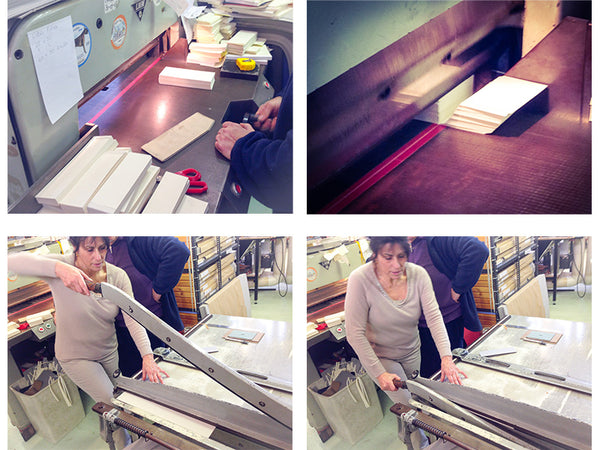
Once the block has been selected and trimmed to size, it is time to unite it with the cut-out and embossed leather. In a few quick, deft motions, the block is run through a revolving press, a bit like a mangle. This coats it with a fine layer of glue from the roller, which is fed from a bubbling pot of the treacly liquid. The block is snatched from the roller immediately, then aligned with and pressed onto the leather cover by hand, binding the two firmly and evenly together. It is then put in another press for five minutes while the glue dries. While the team at Amarcord make all this look easy, moving with the assurance and dexterity born of long practice, we Scriptonians kept our hands safely tucked in our pockets, imagining accidentally gluing our fingers to that inexorably revolving mangle.

If the journal has any extra features, such as a tie closure, this is the time to add them. A thin leather thong, stamped out of leather by the same process as the journal covers, is looped carefully through the holes; a fiddly process. Then a beechwood bead, sourced from Bergamo (just north of Milan) is threaded on to make a toggle closure, and the ends of the thong neatly tied and snipped. 
And finally, the journal is finished! Although we have been working with Amarcord for several years, it was inspiring and somehow humbling to see how much attention to detail, how many years of experience go into producing each and every journal handmade in their workshop. It all comes back to provenance: if you know where something comes from, you can be assured of not only its quality, but the tradition in which its making is rooted. It was fascinating to discover the story behind each part of our journals, and to meet the people whose passion for traditional leatherwork keep us journal-lovers supplied with the objects of our desire. We can’t wait for the new styles we have ordered to arrive!
